|
This Site:
Slavery Home
Slavery History
Slave Photographs
Slavery Pictures
Slave Maps
Slave
Ships
Slave Trader
Abraham Lincoln
African American Art
Civil War
Civil War Overview
Harper's Weekly
Links
Search this Site
Civil War Art
Mexican War
Republic of Texas
Westward Expansion
Winslow Homer
Thomas Nast
Mathew Brady
Western Art
Civil War Gifts
|
|
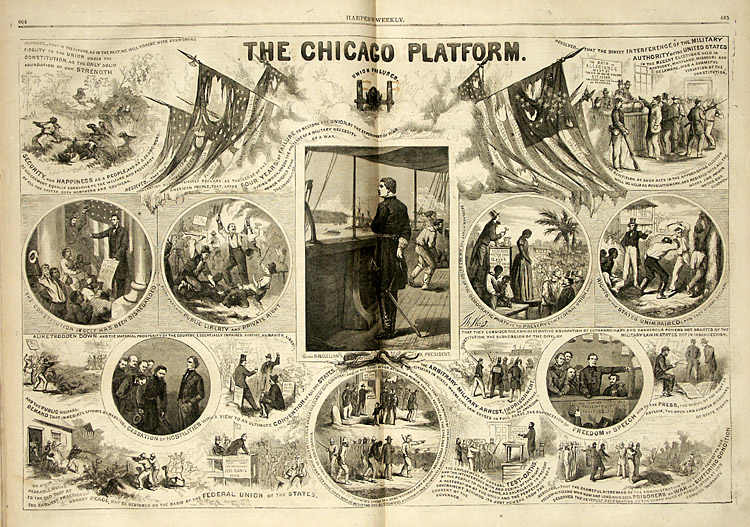 |
1864 Presidential Campaign
By 1864, the Country had grown weary of the long and bloody
Civil War. Hundreds of thousands
of the countries' best and bravest young men had fallen on the fields of
Bull Run, Antietam, Shiloh, and countless more. Many began to think that the
war was not worth it, and the price of freedom too great. The Republican
Presidential Candidate
Abraham Lincoln thought no price was too great for the abolition of
slavery and the creation of a society in which a man was not judged by the
color of his skin. Unfortunately, after four long years of war, Lincoln's
support was dropping fast, and people were looking for a way out of the war.
With this backdrop, the Democratic Party chose
General George McClellan to be their Presidential Candidate at the
Chicago National Convention in 1864. The
Democratic Party Platform presented a plan of "Compromise with the
South", which became known as "The Chicago Platform". While on its surface
the Chicago Platform was seductive in that it promised an immediate
cessation of hostilities, and a restoration of the union. What was unsaid in
the platform, but clearly implied, was that the "compromise" would be to
agree to make permanent the institution of slavery in exchange for an end to
the Civil War and restoration of the Union. In other words, the Democratic
party was ready to "Sell Out" the enslaved, in order to stop further loss of
white lives. This is reflected in
McClellan's acceptance speech, where he stated:
The reestablishment of the Union, in all its
integrity, is and must continue to be the indispensable condition in any
settlement.
If reestablishment of the union was the only "condition" that was
"indispensable", then clearly the issue of abolition of slavery was
dispensable, and the possibility of Slavery being permanently
institutionalized in our country was on the negotiation table.
Thomas Nast
exposed the hypocrisy of the Democratic Platform with his stunning
illustration entitled "The Chicago Platform", which is shown above. In this
illustration, Nast wrote out the "words" of the democratic platform,
and wrapped the words around dramatic illustrations indicating what the
words really meant. In effect, Nast "decoded" the words of the
platform in his illustration, to clearly communicate what the Democrats
stood for . . . continuation of the institution of slavery in exchange for
an end to the war.
This is an incredible illustration, so I will
present detailed views of the various inset illustrations for your research
and perusal. Below, I show Close Ups of the various parts of this incredible
illustration. |
|
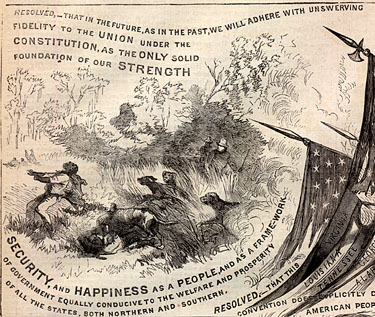
Illustration of a Slave Hunt |
The
Democratic Platform:
The 1864 Democratic Platform began with the
words:
Resolved,
that in the future, as in the past, we will adhere with unswerving fidelity
to the Union under the Constitution, as the only solid foundation of our
strength, security, and happiness as a people, and as a framework of
government equally conducive to the welfare and prosperity of all the
States, both Northern and Southern.
Nast wrapped these words
around an image of their true meaning, showing men and dogs hunting down
runaway slaves. The image to your left presents this portion of the
illustration above. |
|
Nast points out in this drawing that the
"people" referred to were clearly the white people. That returning to the
Constitution of that day meant a return to a country where Blacks were
property, and had no rights. The "Prosperity of the Southern States" clearly
was a Democratic Promise to make slavery a permanent institution in the
country, in exchange for an end to the Civil War.
The next section of the Democratic Platform
reads:
Resolved,
that the direct interference of the military authorities of the United
States in the recent elections held in Kentucky, Maryland, Missouri, and
Delaware, was a shameful violation of the Constitution, and a repetition of
such acts in the approaching election will be held as revolutionary, and
resisted with all the means and power under our control.
In mid-term elections, the Government
required that Citizens be loyal to the Union in order to vote, and the
military was present to ensure free and fair elections, without intimidation
from Treasonous Northerners, Confederate Sympathizers, and those enriched by
the Slave Trade. The democratic
party opposed this, and believed that those slave-sympathizers engaged in
treason against the country should be allowed to vote, and be allowed to
intimidate others. In the inset image below, Nast illustrates the free
and safe elections, which were so offensive to the Democrats of the day.
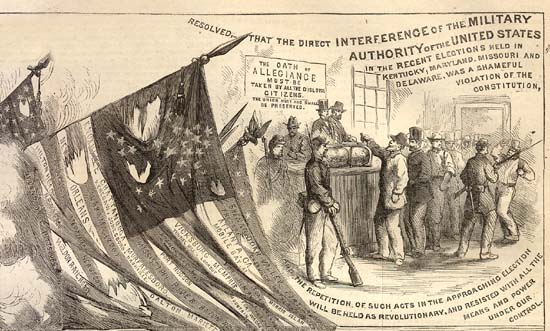
The Chicago Platform went on to state:
"the Constitution itself has been disregarded
in every part, and public liberty and private right alike trodden down"
The issue referred to here is that Abraham
Lincoln had issued the Emancipation Proclamation in 1863, which freed the
slaves. The Chicago Platform viewed this as disregarding the
constitutional rights
of Southerners. Specifically, the right to own slaves, to beat
slaves, and to kill slaves. The Nast illustration captured this irony by
wrapping these words around two illustrations . . . one shows Lincoln
Freeing the Slaves, and the other shows the "old way", in which blacks were
owned, beaten, and tortured at the whim of whites.
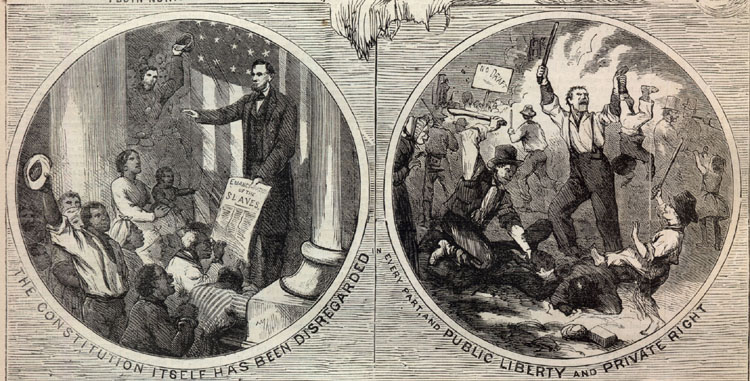
The Chicago
Platform further reads:
that the aim and object of the Democratic
party are to preserve the federal Union and the rights of the States
unimpaired
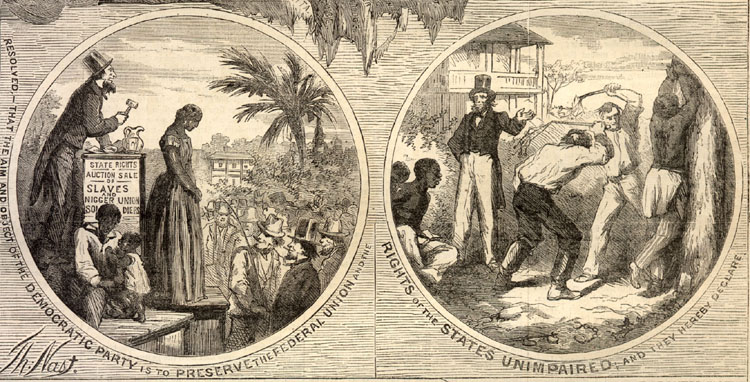
Nast's
Illustration then points out that the "Rights of the States Unimpaired" was
a nice way of saying, "States may Continue to practice Slavery, with all its
associated brutality, unencumbered by the Federal Government". The
illustration shows a slave auction. At the slave auction, a black
family is being sold. The Mother is being sold separately from the
child and Husband. Clearly, the family was being split apart and sold
separately. In the second image, a black man is shown tied to a tree
and being brutally beaten by two men with whips. Other slaves are forced to
watch the brutality, I suppose as a warning to them. All this was
accepted practice in the United States of the 1850's and 1860's. The
Democratic Platform of 1864 was strongly supporting continuing this practice
as "Business as Usual".
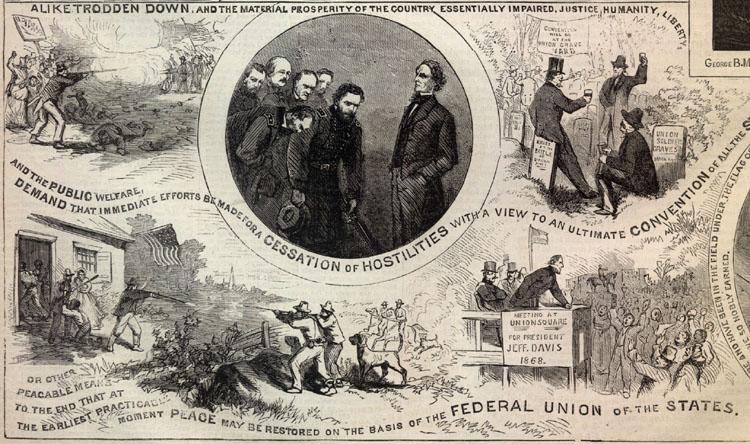
This part
of the illustration, which is the lower left of the original leaf, shows
other implications of compromising with the south, as the Democrats wanted.
Slave hunters are shown moving North, and attacking Northern families that
are harboring runaway slaves. Union Generals are shown bowing to
Jefferson Davis, paying homage to the Rebel Leader. Southern Rebels
are shown drinking and celebrating over the graves of Union Soldiers, who
had died in a useless war. Perhaps most inflammatory, is the illustration
suggesting that if the Democrats were successful, Jefferson Davis could
potentially be a strong candidate for President of the United States in
1868. |
|
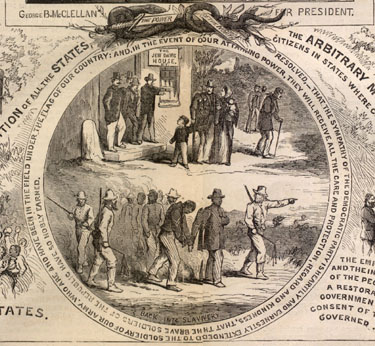
Buffalo Soldiers Returned to Slavery |
While
totally undermining the Union Army, and what it was trying to do, the
Chicago Platform went on to allege its support of the individual soldiers
and their families.
Resolved, that the sympathy of the Democratic
party is heartily and earnestly extended to the soldiers of our army and the
seamen of our navy, who are and have been in the field under the flag of
their country; and, in the event of its attaining power, they will receive
all the care, protection, and regard that the brave soldiers and sailors of
the republic have so nobly earned.
Nast's
Illustration pointed out the Hypocrisy of alleging to support the Soldier,
while undermining what they are fighting for. The words above are wrapped
around a picture of Black Buffalo Soldiers in the Union Army being captured
and returned to their Slave Owners. Since this would be the |
|
outcome of the Democratic Platform, the Nast
illustration points out that the Democrats "sympathy" must have only
extended to the White Soldiers, as the Blacks would have been returned to
Slavery.
This Nast Illustration entitled "The Chicago
Platform" was published on October 15, 1864, shortly before the 1864
Presidential Election. It was printed in Harper's Weekly, the most popular
illustrated newspaper of the day. Harper's Weekly was read by approximately
1,250,000 people each week. This was a reasonable fraction of the
voting public of the day. At the point this illustration was published, few
thought that Abraham Lincoln had much of a chance of winning a second term
as President of the United States. The country had grown weary of the cost
of the war; both the monetary and human cost, and was being won over by the
promise of the Democratic Party to end the War, to end the pain, and to end the
suffering. This seductive message had began to gain traction, and our
country was on the verge of accepting Slavery as a Permanent, and Protected
National Institution.
The Thomas Nast Illustration of "The Chicago
Platform" helped to raise the righteous indignation of the Nation. It
helped to remind us what we were fighting for, and why so many had suffered
and died. It helped remind us that as a Nation we could only be Truly
Free if we were All Free. It showed that if we gave up before we won, all
had died in vain, and their sacrifice was for nothing. It helped us to
realize that there was a purpose, and that the victory had yet to be won.
It helped give us the strength to fight on.
With the help of Thomas Nast, and his
Powerful Illustration, Abraham Lincoln did win the 1864 election. The Union was restored, and
Slavery was abolished, once and for all. The Nation was put on a new
path of freedom and justice for all. This illustration helps to
show the "power of the pen", and that Thomas Nast was a Master Illustrator
whose Pen helped shape our Nation, and the freedoms we still enjoy.
|
|
We created this
Thomas Nast Gallery to digitally preserve Nast's Slavery work for
posterity. We are now making the original, 140 year old leafs
available for a $250 contribution to this site. The proceeds from the sale of the
material will enable us to continue to expand the free educational material featured on our
site. Please contact
paul@sonofthesouth.net
if you are interested in acquiring one of these original leafs. |
|
|
|
 |
|
![]()
![]()






